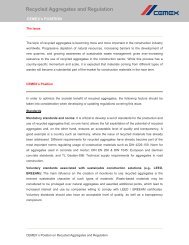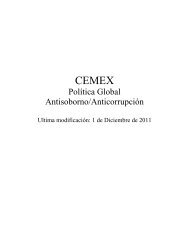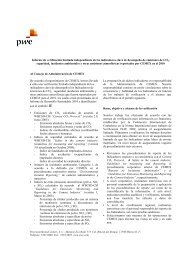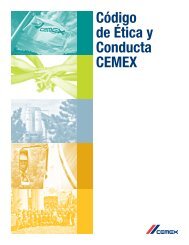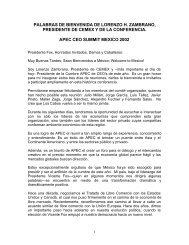building a STRONGER foundation - Cemex
building a STRONGER foundation - Cemex
building a STRONGER foundation - Cemex
Create successful ePaper yourself
Turn your PDF publications into a flip-book with our unique Google optimized e-Paper software.
C) USE OF ESTIMATES<br />
CEMEX, S.A.B. DE C.V. AND SUBSIDIARIES<br />
Notes to the Consolidated Financial Statements – (Continued)<br />
As of December 31, 2010, 2009 and 2008<br />
(Millions of Mexican pesos)<br />
The preparation of financial statements in accordance with MFRS requires management to make estimates and assumptions that affect<br />
reported amounts of assets and liabilities and the disclosure of contingent assets and liabilities at the date of the financial statements, as well<br />
as the reported amounts of revenues and expenses during the period. These assumptions are reviewed on an ongoing basis using available<br />
information. Actual results could differ from these estimates.<br />
The main captions subject to estimates and assumptions include, among others, long-lived assets, allowances for doubtful accounts and<br />
inventories, deferred income tax assets, the measurement of financial instruments at fair value, and the assets and liabilities related to<br />
employee benefits.<br />
D) FOREIGN CURRENCY TRANSACTIONS AND TRANSLATION OF FOREIGN CURRENCY FINANCIAL STATEMENTS<br />
Transactions denominated in foreign currencies are recorded at the exchange rates prevailing on the dates of their execution. Monetary assets<br />
and liabilities denominated in foreign currencies are translated into pesos at the exchange rates prevailing at the balance sheet date, and the<br />
resulting foreign exchange fluctuations are recognized in earnings, except for exchange fluctuations arising from: 1) foreign currency<br />
indebtedness directly related to the acquisition of foreign entities; and 2) fluctuations associated with related parties’ balances denominated in<br />
foreign currency that are of a long-term investment nature. These fluctuations are recorded against stockholders’ equity, as part of the foreign<br />
currency translation adjustment of foreign subsidiaries (note 16B).<br />
The financial statements of foreign subsidiaries, which are determined using the functional currency applicable in each country, are translated<br />
to pesos at the closing exchange rate for balance sheet accounts and at the average exchange rates of each month for income statement<br />
accounts. The corresponding translation adjustment is included within “Other equity reserves” in the balance sheet. The closing exchange<br />
rates and the approximate average exchange rates for balance sheet accounts and income statement accounts, respectively, in 2010, 2009 and<br />
2008, were as follows:<br />
2010 2009 2008<br />
Currency Closing Average Closing Average Closing Average<br />
United States Dollar........................... 12.3600 12.6700 13.0900 13.6000 13.7400 11.2100<br />
Euro ................................................... 16.4822 16.7106 18.7402 18.9186 19.2060 16.4394<br />
British Pound Sterling........................ 19.2854 19.5404 21.1436 21.2442 20.0496 20.4413<br />
Colombian Peso ................................. 0.0065 0.0067 0.0064 0.0062 0.0061 0.0056<br />
Egyptian Pound.................................. 2.1285 2.2410 2.3823 2.4483 2.4889 2.0578<br />
Philippine Peso .................................. 0.2819 0.2813 0.2833 0.2845 0.2891 0.2509<br />
The financial statements of foreign subsidiaries are initially translated from their functional currencies into dollars and subsequently into<br />
pesos. Therefore, the foreign exchange rates presented in the table above between the functional currency and the peso represent the exchange<br />
rates resulting from this methodology. The peso to U.S. dollar exchange rate used by CEMEX is an average of free market rates available to<br />
settle its foreign currency transactions. No significant differences exist, in any case, between the foreign exchange rates used by CEMEX and<br />
those exchange rates published by the Mexican Central Bank.<br />
E) CASH AND INVESTMENTS (note 4)<br />
The balance in this caption is comprised of available amounts of cash and cash equivalents, mainly represented by short-term investments of<br />
high liquidity, which are easily convertible into cash, and which are not subject to significant risks for changes in their values, including<br />
overnight investments, which yield fixed returns and have maturities of less than three months from the investment date. Those fixed-income<br />
investments are recorded at cost plus accrued interest. Other investments which are easily convertible into cash are recorded at market value.<br />
Gains or losses resulting from changes in market values and accrued interest are included as part of the Comprehensive Financing Result.<br />
Beginning on January 1, 2010, based on new MFRS C-1, “Cash and Cash Equivalents,” restricted amounts of cash and investments,<br />
comprised by deposits in margin accounts with suppliers and financial institutions that guarantee CEMEX obligations under commercial<br />
transactions as well as those associated with derivative financial instruments, to the extent that the restriction will be lifted in less than three<br />
months at the balance sheet date. When the restriction period is greater than three months, such restricted cash and investments are not<br />
considered cash equivalents and are included within short-term or long-term “Other accounts receivable,” as appropriate. When contracts<br />
contain provisions for net settlement, these restricted amounts are offset against the liabilities that CEMEX has with its counterparties.<br />
F) INVENTORIES (note 7)<br />
Inventories are valued using the lower of their production cost and market value. Production cost may correspond to the latest purchase price, the<br />
average price of the last purchases or the last production cost. CEMEX analyzes its inventory balances to determine if, as a result of internal events,<br />
such as physical damage, or external events, such as technological changes or market conditions, certain portions of such balances have become<br />
obsolete or impaired. When an impairment situation arises, the inventory balance is adjusted to its net realizable value, whereas, if an obsolescence<br />
situation occurs, the inventory obsolescence reserve is increased. In both cases, these adjustments are recognized against the results of the period.<br />
F-10



